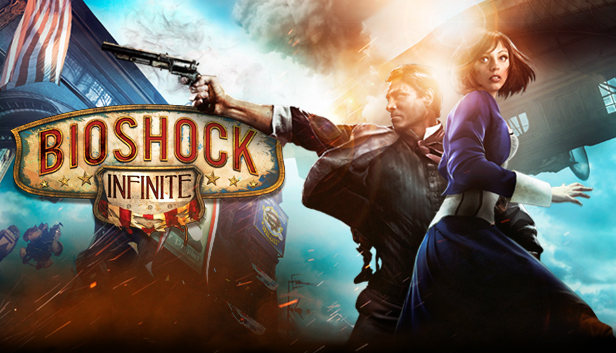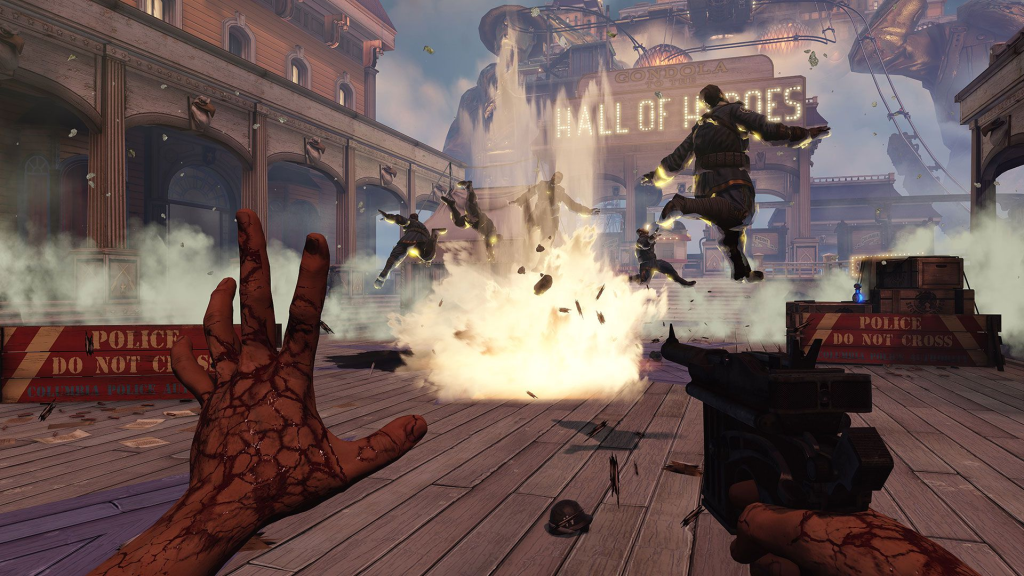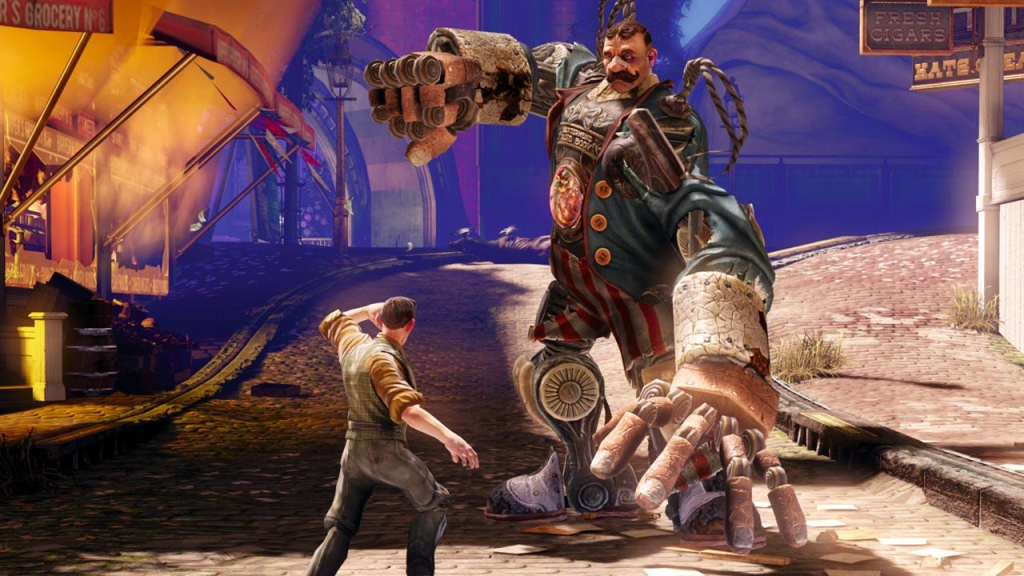
Booker DeWitt’s Journey to Columbia is a one-of-a-kind adventure set in a setting unlike its predecessors but maintaining the essential elements that distinguish the BioShock series.
Infinite is a fascinating, multi-layered plot, but it is not without problems. Because he was commissioned to discover and deliver a young woman to New York, the main character finds himself in a mystery sky city. Of course, things rapidly become complex as Elizabeth and Booker find themselves in the middle of a civil war and a battle for survival in highly perilous circumstances. The promised land’s metropolis is transformed into a flying, living nightmare.
The script is well-written and intriguing. It has many twists and turns, as well as some devastating situations. Many times, I stopped for a moment to observe not only the gorgeous scenery, but also little snippets of citizen life, which brilliantly represented the contradiction of living in Columbia. It was every 19th-century nationalist’s wet dream to believe that his race had been selected to construct the New Eden. A diseased moral code and abstract notions with squiggles at the level of cosmological-quantum difficulties control this universe. Columbia is teeming with live individuals whose mentalities and ideas, instilled by its theocratic leader, the prophet Comstock, provide fodder for thought. People of colour are regarded as a lower caste in this society of white men. All that is un-American is a product and a set of ideals fit for Sodom, which “Columbia left ascending into the heavens.” The development of all the characters is as intriguing as the game environment itself. Significant characters are quite diverse individuals, and one of the things that the creators at Irrational Games are excited about is progressively getting to know their personalities. Colourful personas and discussions will stay with me for a long time. Elizabeth, the destination of our tour to the utopia for racists and eugenics enthusiasts, is unquestionably the favourite. She is a lively and inquisitive young lady whose narrative will take you by surprise in various ways. The moments when we witness her responses to new things are precious.

She becomes our constant companion from the minute we encounter her, accompanying us across the soaring city. She enables herself to continually remark on the environment around her, so even the sections of the game that aren’t full with action are fascinating. Even in combat, she is really helpful and helps us get out of difficult circumstances owing to her unique abilities. Ken Levine, the designer of BioShock Infinite, promised a different tale than the earlier portions of the game, and he succeeded completely. It’s a heartfelt narrative at moments, but it may also pose moral concerns that have hitherto gone unnoticed in computer games. The narrative is presented from the start as an entertaining novel, and despite the obvious finish, it might surprise with the selected method of storytelling. So what if you have a sneaking suspicion of what will happen if you can’t pull yourself away from the computer and devour the visuals given with bated breath? I can’t say the same about the gaming mechanics and elements that I focused on. If you liked the Bioshock series because of the coherence of the portrayed universe, owing to subtleties like the explanation of the history of innovations, you’ll be a little disappointed here. The origin of vigors, or plasmid counterparts, is not described in any detail. There is no information on whether they change the genetic code or provide new powers miraculously. We drink them as tonic, and that’s it; we’re ready to employ them. Yes, we know who invented them, but this is only a cursory understanding, because their creator built nearly most of the technologies at Columbia, yet none of them is detailed in depth.
The allure of understanding the roots of some of the game’s unique solutions, as seen in Levine’s prior games, has vanished. An intriguing example is the commercial that appears at the start of the game. It advertises a brand of smokes aimed towards children. What makes them unique enough that minors can smoke them? Do they have nicotine in them? There will be no mention of anything, leaving us with the sensation that the designers dropped some fascinating concepts into the universe but neglected to finish expressing them. They, on the other hand, give opportunity for interpretation. The vigors stated above are powers similar to those shown in previous portions, but because they can be developed, they become even more essential instruments in the struggle for life. There are numerous weapons, but diversity is an illusion. Almost half of the rifles and handguns on the market are basic modifications. So we have a quick-firing pistol and a more powerful option in the shape of a slower revolver. Machine guns differ so subtly that only aesthetics are considered. The aesthetic aspect of weapon modifications is what I consider a step backwards. We may enhance our weapons of devastation, like we have in prior BioShock chapters. I immediately spent the majority of the money I raised to enhance a handful of my favourite guns, having grown accustomed to the brilliant-looking ultimate versions of Rapture goods. Unfortunately, their look hasn’t altered much, despite the fact that their effectiveness is improving as anticipated. Clothing that alters our combat abilities is a new feature in the game. It might increase our chances of catching fire or boost our regeneration. Finding all of the outfits is a fun task that pushes you to go throughout the world. Another difference from traditional shooting is the ability to employ hooks and rails strategically placed around the city for rapid connection between the city’s flying regions.

Booker has a particular catch that allows it to alter its position at any time by leaping onto one of these transit lines. We leap across the whole terrain, killing everybody who gets in our way with an array of Elizabeth’s powers, weapons, and special skills at our disposal. The game’s speed is incredible, and it will keep you entertained for hours. This might be due to practice, but I found the normal difficulty level to be easier than in prior games. Fans of bigger obstacles will most likely find pleasure only in the unique 1999 Mode, which compels us to battle for every bullet and opponents do not pardon even the smallest error. We shall face numerous opponents, but they will be far from the variety seen in Rapture. We have ranged and melee varieties for regular people. Despite the fact that there are bottles of vigors all over the place, we only meet two of them throughout the game. After a time, it begins to miss the madmen from the undersea metropolis, who were loaded with plasmids and threw them around like crazy, continually posing a new threat. The stronger variations are armed automatons that will not stop until they have filled us with lead. Several times, half-human half-robots enter the Handyman game, and despite their size, they are as nimble and speedy as enormous chimps. Songbird, who is Elizabeth’s protector and guardian of the sky city, may also surprise and confuse us at times. When I heard sounds that reminded me of him around midway through the game, the hair on the back of my neck sprang up, and I was hiding in some building, listening to my own breathing. His continuous and sudden interference in our Columbia activities effectively heightens the tension and sensation of peril.
Although it is a lovely city with distinctive architecture and ambiance, the devil is in the details. At first appearance, the console version contains various items with extremely low-quality textures. These are not faraway items or buildings, but rather things we see up close, such as a light on a desk or a zeppelin balloon that we visit. Everything is pixelated. The animation frequently opens the door for us, and the hero places his hands on the low-quality texture of the door. The number of visible frames per second reduces considerably at times. Of course, we won’t notice these flaws on the PC version on a good-quality machine, where the game looks fantastic at the maximum graphical settings. The haphazard placement of goods in the containers ruins some of the uniformity. Everything had a place in Rapture: we found booze in illicit containers, money in the safe, and food in cabinets. During a visit to the sky city, I wondered who throws money in the rubbish or puts lockpicks in a prison cell chest. I stole a few bucks and a chocolate cake after opening the cash register. Exploration for raw materials and equipment pieces also allows you to locate recordings spread about the city, which often disclose significant story mysteries. This is a familiar aspect from earlier sections, although many recordings included flaws in the form of no sound. The only way to find out what was in the transcript was to look for it in the popup menu after playing. Elizabeth occasionally starts talking to us and drowns out anything we play; on the other hand, the journal we listen to can entirely drown out the newly begun scenario connected to the main thread of the tale.
In the end, Bioshock Infinite revealed itself to be an entirely distinct story, which, based on the plot and the depicted environment, makes no sense to compare to the prior chapters. It’s a well produced novel with gratifying surprises and a large cast of supporting characters to come to know. Individual solutions to game mechanics and attention to detail provide a forum for possible conversation. The compelling plot, engaging city, and exciting gameplay, however, offset the mistakes and faults. It’s well worth it!
